Health care furnishings to meet any challenge
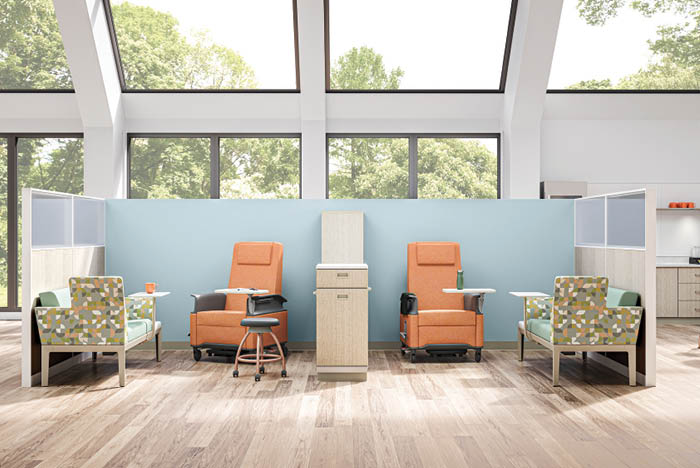
Image from Steelcase Health
Manufacturers of hospital furnishings are meeting the needs of health care providers by focusing on ergonomics, cleanability, aesthetics and customization in their latest offerings. Modular furnishings that offer flexible connections and arrangements are especially popular. This includes multi-use seating choices with safety, comfort and the ability to improve the patient experience being top priorities.
The latest furnishing innovations offer comfort and ease of use for patients and caregivers; furniture that fits into smaller footprints and offers greater functionality; a more hospitality style; a lighter look and feel; and the use of environmentally friendly materials. Because of the COVID-19 pandemic, cleanability of furnishings also has taken on greater importance.
“Hospitals are asking us to focus on more metal versus wood materials for infection control, durability and bariatric needs,” says Pam Krill, director of product marketing at Steelcase Health, Grand Rapids, Mich. “There also is a focus on a greater variety of finishes and colors for a warmer, more welcoming aesthetic. And exploring more capabilities in upholstery using silicone and vinyl without phthalates for cleanability, durability and infection prevention are top of mind.”
Furnishings trends
Due to infection control measures that involve increased cleaning protocols, more hospitals are requesting non-woven fabric, says Jessica Mathieson, vice president and general manager of acute care at Stryker, Kalamazoo, Mich. “Historically, woven fabrics have been used on the backs of chairs in waiting rooms or lounge areas. With the need for increased cleaning and disinfecting of all areas, hospitals are now choosing all-coated fabrics and, specifically, vinyl because it withstands rigorous cleaning procedures better than other coated fabrics.”
The emergence of COVID-19 has affected many furniture design issues, agrees Michelle Ossmann, director of knowledge and innovation for health care at Herman Miller, Zeeland, Mich. “For example, we’ve long known that people are generally disinclined to sit next to strangers, but the need for seating density in waiting spaces drove furniture layouts with tight seating arrangements. COVID-19 and the need for patient distancing upended these dense seating layouts, giving people space they originally wanted, yet now need for safety.”
How hospital furnishings are designed often dictates how they can help hospitals meet infection prevention protocols. Furnishings designed specifically for clinical environments typically can withstand the rigors of daily use that are unique to that environment. “But what’s often missing are design elements that can play a part in infection prevention,” says Brian Hazelwood, marketing manager at Midmark, Dayton, Ohio. “For instance, cabinetry that features Environmental Protection Agency-registered antimicrobial pulls, nonporous surfaces that are self-sanitizing, and seamless upholstery that is easier to clean and disinfect.”
Ergonomics continues to be a critical issue for hospital furnishing providers, especially as it relates to people interacting with technology. In fact, caregivers in hospitals spend approximately half of their shifts using technology, says Steven Bramson, president at Innovative Ergonomic Solutions, Easton, Pa. “Providing portable and adjustable solutions such as a workstation on wheels creates better conditions. When a caregiver can effortlessly interact with the patient, and not have to worry or struggle with the technology or the furniture, it results in a higher level of care.”
Furnishing styles are moving rapidly toward a more inviting residential feel, says Suzanne Fawley, behavioral health interior designer at Stance Healthcare, Kitchener, Ontario. “Seating products for persons of size, formerly called bariatrics, are now included in furniture collections — instead of ‘one-off’ pieces to accommodate that need — and thus lead to a more dignified patient experience. Also, many of these seating collections can be built to suit the needs of behavioral health environments, where preventing self-harm and harm to others and maximizing durability are a prime focus.”
Home care is a growing trend as health care providers explore options to treat patients at home to reduce costs associated with brick-and-mortar facilities. This presents new opportunities for furniture manufacturers to develop home care options that help support these patients, says Darryl Metheny, regional sales director at Champion Manufacturing Inc., Elkhart, Ind.
“An example may be a recliner that allows patients to receive intravenous therapies for oncology or dialysis while at home, and provides proper positioning and comfort for longer periods of time,” Metheny says. “Partnerships will need to be forged between service providers and manufacturers to develop ways to cost-effectively deploy these types of products.”
Seating features
Many furnishings introduced to the health care market incorporate modular, building-block features. For example, Allseating, Mississauga, Ontario, has introduced the Rühe collection, which is comprised of single seating (guest, patient and lounge), tandem seating and tables. Guest seating includes a standard seat size, and a plus or love seat to accommodate a broad range of body types. Rühe’s 14-gauge steel frame features seven support ladders and 10 arm variations that contribute to 15 standard seating configurations and numerous possibilities with linking tables and mid-arms. The collection is designed to create cohesiveness throughout waiting, lounge and patient rooms.
The Alō recliner from Champion offers many customizable elements. It is available in two working heights (treatment or recovery), and users can select different back styles, vanity panels, tables and premium coverings. Patient empowerment items such as powered recline, a USB port and heat/massage can be added. Clinical functionality also has been engineered into the Alō, which includes swing-away arms and a removable seat for ease of cleaning and disinfection, the Trendelenburg position for acute reactions, and 4-inch twin-wheel casters, retractable foot trays and push handles for patient transport.
MyPlace high-back seating from KI, Green Bay, Wis., is designed for a wide range of gathering areas, from small touchdown nooks to lobbies to café environments. “MyPlace high-back seating integrates power management into its design and is durable with a 400-pound weight rating. Its modular design allows pieces to be added and removed as needs change,” says Jonathan Webb, workplace market director.
Stance Healthcare, Kitchener, Ontario, which focuses on the behavioral health design space, has released its Spry seating collection, a group of seating and tables that emphasizes flexibility, cleanability and durability. Featuring solid surface arm caps, Spry offers 360-degree cleanout for maximum infection control, and coordinates with linking tables to create space between users.
Steelcase Health offers Empath recliner seating, which adapts to a wide range of uses in clinical spaces, including patient and exam rooms and infusion spaces. “Empath features are designed from real-world insights to improve the patient experience through safety and comfort while promoting overall quality of care,” Krill says. “Empath adheres to stringent Steelcase standards for durability and performance, with a thorough static and dynamic testing process that exceeds industry standards to ensure a long product lifespan.”
Kwalu, Atlanta, has introduced the Modena patient chair and ottoman for patients seeking a comfortable, supportive seat as they recover in their hospital rooms. The ottoman is designed to coordinate with and easily store under the patient chair, taking nothing from the room footprint. The frames of the chair and ottoman are durable, bleach-cleanable and contain a steel-reinforced joint system. The frames are not wood, but wood’s warmth and elegance has been reimagined into Kwalu’s long-lasting finish, the company states.
Cama Collection LLC, New Haven, Conn., has introduced the Cama Care Chair, a new addition to its IOA Cama Collection. “With the knowledge gained in our investigation of ‘purposeful sitting,’ this chair addresses sleep and stability, care and comfort, memory and motion, exercise and engagement, and love and support,” says Rosalyn Cama, president. “As bed rest is deeply rooted in hospital culture, this chair helps to transition bedside to chairside care in a way that lowers length of stay and improves patient mobility after treatment.”
Stryker has unveiled its Unity furniture line, which can withstand the intensive cleaning procedures associated with today’s infection control requirements. Unity has open-slat design and 360-degree cleanout spaces to prevent particles from getting stuck in crevices. The sleepers have a moisture-barrier surface to protect the durability of the product while withstanding cleaning protocols. “Unity offers features such as a waterfall front design, sealed seams, removal of exposed wood, nonporous self-skinned urethane arm caps and high-density Ultracell foam,” says Mathieson.
Casework options
Herman Miller’s Commend nurses’ station combines the benefits of prefab with the beauty of millwork, according to Ossmann. “With Commend, we set out to create the most beautiful prefab solution possible. Its modular design is sleek and linear, and functions as a set of building blocks for creating different team spaces while maintaining aesthetic cohesion across facilities.” Commend was designed with protective details to increase its longevity. Corner protectors shield corners from dents and marks, and materials such as Corian cladding and stainless-steel toe-kick panels increase its durability. Additionally, damaged components can be easily replaced.
HAT Healthcare, part of Innovative Ergonomic Solutions, offers a selection of mobile workstations that are configurable and durable. “The workstations feature vertical height adjustability and can be configured to be powered or nonpowered, allowing caregivers and information technology departments to meet the needs of the workspace,” Bramson says.
Midmark has introduced Synthesis wall-hung cabinetry and a mobile procedure cart. The cabinetry is designed to improve ergonomic reach and visibility while enhancing storage efficiency and supporting infection prevention. Primary features include lower upper height and thinner depth of cabinets to improve access to storage with less reach and lean required, and the use of gravity-fed, angled flow-shelving to improve visibility and access to supplies.
Available in three models, the Midmark mobile procedure cart is designed to support health care-related procedural work from a standing position. Features include a no-tip base design and a slide-out work surface that offers an additional working area. “Thanks to a number of optional features, including storage racks and mounting accessories, caregivers have the ability to design the cart to work the way they need it to work,” according to Hazelwood.
Advances ahead
For the future, sensors and smart technology will assist the eyes and ears of the caregiver, sending alerts and just-in-time diagnostics for care and safety interventions, predicts Cama. “Many nonmedical devices are already care-capable; we will see these technological advances being adopted into hospital furnishings soon. Transportation seating has already adopted these smart features.”
Webb says another advance will occur in virtual care practices. “Furniture manufacturers should look to integrate technology into more of their products to accommodate comfortable and flexible virtual care settings.”
Modularity will continue to grow in importance, says Ossmann. “Planning with modular casework and furnishings allows hospitals to properly handle ever-evolving situations and alleviate the stress that fixed, singular-use products and design often can cause during transitions.”
Neal Lorenzi is a freelance writer and regular contributor based in Mundelein, Ill.

SIT BACK
Empath recliner seating adapts to a wide range of uses in clinical spaces, including patient and exam rooms and infusion spaces. Steelcase Health

GOING HOME
The Unity glider and chaise lounge sleeper fuse the comfort of home with the durability and cleanability that caregivers expect. Stryker
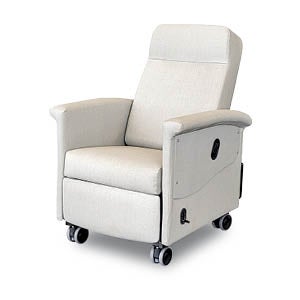
REST AND RECOVER
The Alo- recovery recliner has a lot of the same acute functionality built into it as the treatment height product, but it features a lower seat height. Champion Manufacturing Inc.

TRIPLE THREAT
The Spry seating collection, a group of chairs and tables, emphasizes flexibility, cleanability and durability. Stance Healthcare
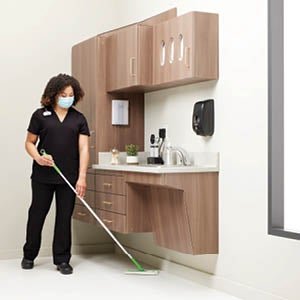
CLEAN CABINETRY
Synthesis wall-hung cabinets simplify cleaning and help maintain a clean, aseptic environment for patients and staff. Midmark
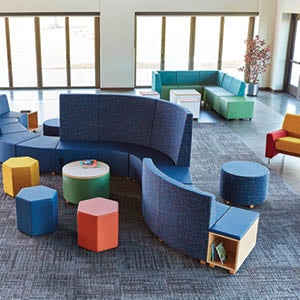
FLEXIBLE FURNISHING
MyPlace high-back seating and lounge furniture feature a modular design, which allows pieces to be added and removed as needs change. KI
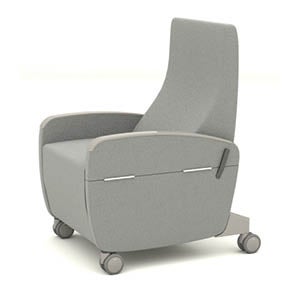
CARE CONTINUUM
The Cama Care Chair helps transition bedside to chairside care in a way that lowers length of stay and improves patient mobility after treatment. Cama Collection LLC
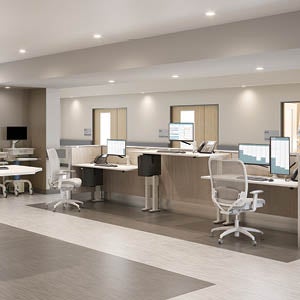
ADAPTABLE ANSWER
The M Quad workstation easily adapts to technology while meeting health care providers’ ergonomic needs. HAT Healthcare
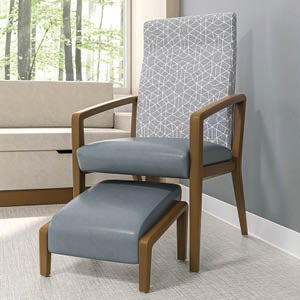
PATIENT SUPPORT
The Modena patient chair and ottoman is designed for patients seeking a comfortable, supportive seat during recovery. Kwalu
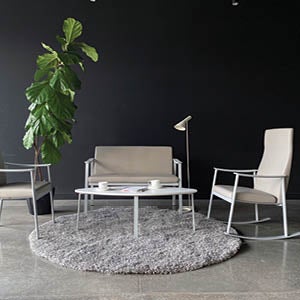
SEATING SELECTION
The Rühe collection is comprised of single seating (guest, patient and lounge), tandem seating and tables. Allseating

TEAMWORK
The Commend nurses’ station functions as a set of building blocks for creating different team spaces while maintaining aesthetic cohesion across facilities. Herman Miller
Neal Lorenzi is a Mundelein, Ill.-based contributor to Health Facilities Management.




